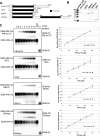Sequence-specific RNA binding mediated by the RNase PH domain of components of the exosome
- PMID: 16912217
- PMCID: PMC1581985
- DOI: 10.1261/rna.144606
Sequence-specific RNA binding mediated by the RNase PH domain of components of the exosome
Abstract
We have previously demonstrated that PM-Scl-75, a component of the human exosome complex involved in RNA maturation and mRNA decay, can specifically interact with RNAs containing an AU-rich instability element. Through the analysis of a series of deletion mutants, we have now shown that a 266 amino acid fragment representing the RNase PH domain is responsible for the sequence-specific binding to AU-rich elements. Furthermore, we found that the RNase PH domains from two other exosomal components, OIP2 and RRP41, as well as from Escherichia coli polynucleotide phosphorylase, are all capable of specifically interacting with RNAs containing an AU-rich element with similar affinities. Finally, we demonstrate that the interaction of the RNase PH domain of PM-Scl-75 is readily competed by poly(U), but only inefficiently using other homopolymeric RNAs. These data demonstrate that RNase PH domains in general have an affinity for U- and AU-rich sequences, and broaden the potential role in RNA biology of proteins containing these domains.
Figures



References
Publication types
MeSH terms
Substances
Grants and funding
LinkOut - more resources
Full Text Sources
Molecular Biology Databases
Research Materials
Miscellaneous
